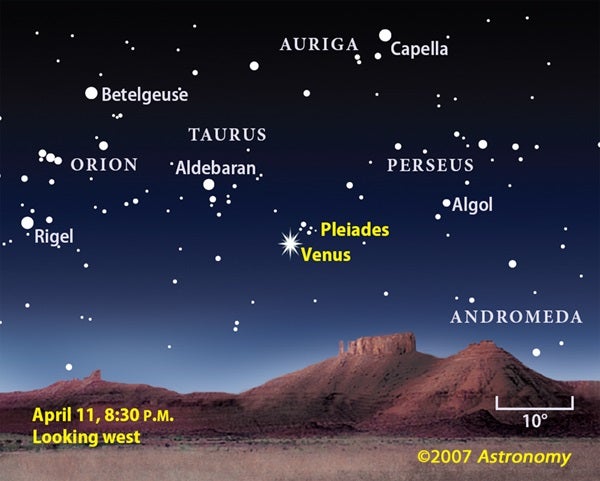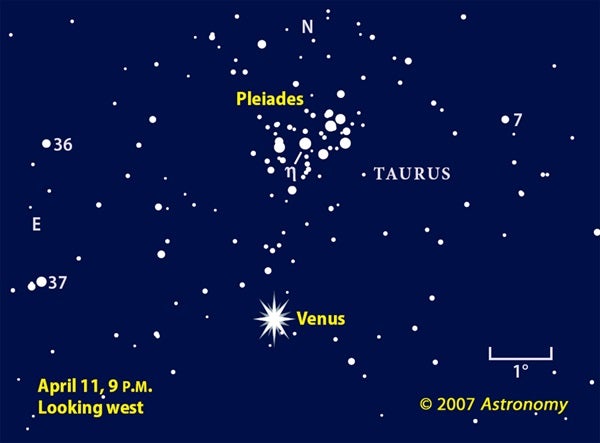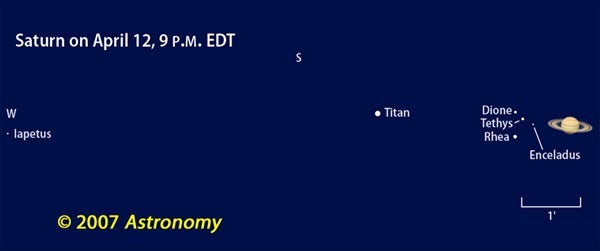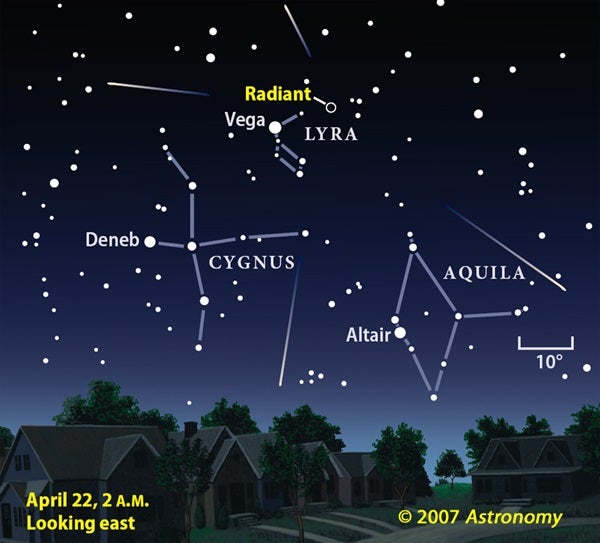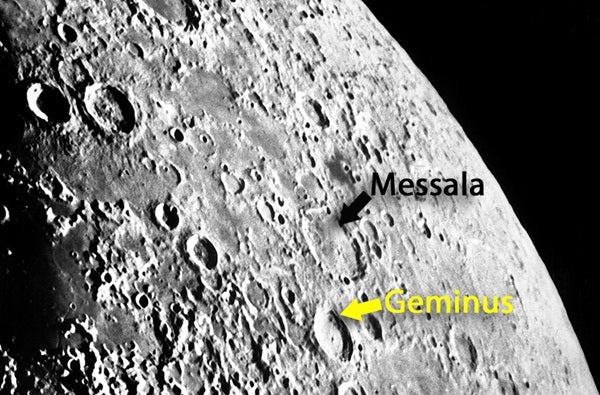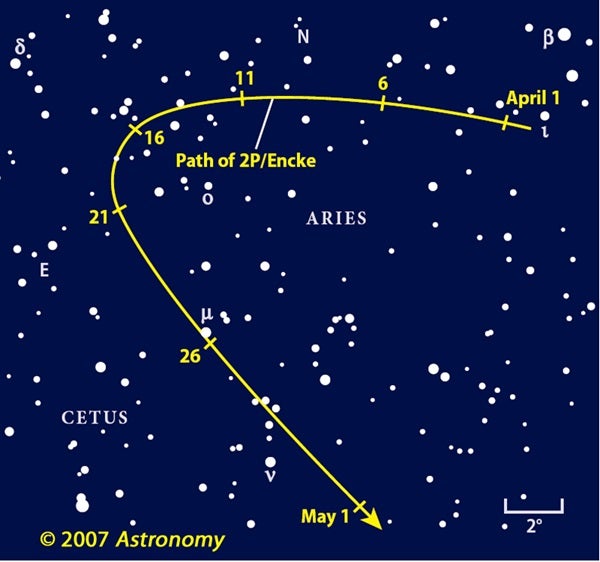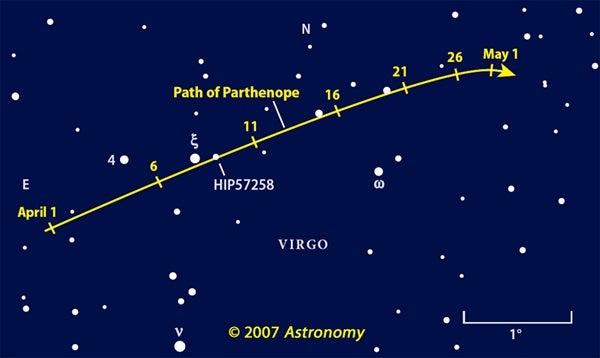As soon as the Sun sets, try spotting Venus about 30° above the western horizon. Thirty degrees is about one-third of the way from the horizon to overhead. The planet shines at magnitude –4.0, bright enough to see in daylight.
Venus remains above the horizon for a long period because the ecliptic now cuts the horizon steeply. This places Venus in a spot that won’t set until 3 hours after the Sun. Viewing Venus in a dark sky
is a rare treat.
As April opens, Venus lies 12° below the famous Seven Sisters star cluster (better known as the Pleiades, and cataloged as M45). Watch Venus each night as it slides in front of the starry background, closing the apparent distance to M45.
Venus lies 2.6° south of M45’s center on April 11. To enjoy the most stunning view, grab 7×50 binoculars. The dazzling cluster of jewels that make up M45 look dim with 4-carat Venus gleaming nearby.
Such alignments are neither particularly rare nor scientifically significant, but they are beautiful. They also present a great opportunity to try astronomical photography.
Viewing Venus through a telescope allows you to follow its changing phases. Venus’ orbital path swings the planet east from around the Sun’s far side. Once Venus reaches its greatest angle east of our star, the planet hooks west and passes almost directly between it and Earth. As Venus doubles back, its disk changes from a nearly full phase to a slender crescent over several months.
During April, observers will see the planet’s illuminated percentage shrink from a gibbous phase of 78 percent to 68 percent. Careful observers may notice the planet’s disk grows in size, too. This is a result of Venus’ shrinking distance to Earth. The disk spans 14″ April 1 and grows to 16″ by April 30. At month’s end, Venus lies 94.8 million miles away — slightly farther than Earth’s average distance from the Sun.
While dazzling Venus beckons, another solar system jewel lies high in the southern sky. Saturn glows at the unassuming magnitude of 0.3. Lying nearly 12° to the right of Regulus, Leo’s brightest star, pale Saturn gives no hint of its underlying beauty. But slew a telescope toward it, and you’ll be rewarded with an otherworldly sight — the orb of Saturn girdled by its spectacular ring system. Even a 60mm telescope can show Saturn’s rings.
At month’s end, Saturn’s distance from Earth tops 9 astronomical units — 837 million miles. The planet’s disk shrinks to an apparent size of 18″. The rings are shrinking, too, as Saturn gradually tilts away from Earth. When they angle edge-on to us in 2009, these thin rings will be all but invisible.
This month, though, Saturn’s axial tilt not only gives us a good glimpse of the rings, but of Saturn’s south polar region as well. Can you spot the slightly darker clouds that make up Saturn’s polar hood? There are few other features to see in Saturn’s atmosphere. Perhaps the equatorial belt, usually its most prominent feature, will be on view. However, storms can stir up deep clouds, which appear as large white spots easily visible from Earth. Keep an eye out for such events.
While Saturn makes excellent viewing, regular changes on the planet are tough to spot. Not so with the moons. Iapetus is a favorite because its dual personality creates a significant change in brightness as it moves from one side of the planet to the other.
This month, Iapetus lies at the brighter half of its orbit. The moon shines at magnitude 10.1 April 13, which is when Iapetus reaches greatest western elongation. Follow the plane of Saturn’s equator 9′ west to find the dim moon; watch for other stars of similar brightness lying within the same field of view.
Saturn’s other visible satellites lie much closer to the planet. For example, when Titan reaches its greatest western elongation, it lies a mere 3′ away from Saturn, one-third Iapetus’ distance.
On April 12, let Titan be your guide to Iapetus. Both moons are near their greatest western elongations. Titan is easy to spot because it shines brightly, at magnitude 8.4. That night, locate Titan, then scan west about 3 times Titan’s apparent distance to Saturn. There, you’ll find dimly glowing Iapetus.
Titan orbits Saturn every 16 days. It passes due north of the planet April 9 and 24, and due south April 16.
On April 24, look for Tethys, Dione, and Rhea in a line on Saturn’s eastern side. These are Saturn’s brightest moons after Titan; they’re usually easy to see under moderate magnification.
Our own Moon lies less than 3° west of Saturn that same night. Canadian observers in Alberta and northwestern British Columbia will see the Moon occult Saturn in the early morning hours of April 25.
By early morning April 26, the Moon will have crossed the gap between Saturn and Regulus. Observers in the western third of the continental United States will be able to watch the Moon occult Leo’s brightest star. Check www.lunar-occultations.com online for details on times for your locale.
Morning planets
The solar system’s largest planet, Jupiter, rises in the southeastern sky just as Saturn, its second-largest planet, descends in the west. By month’s end, Jupiter rises in the southeast before midnight.
Jupiter is a favorite of planetary observers because it displays so many different features. It shows the largest fully illuminated disk of any visible planet. Even a quick glance at Jupiter reveals two dark cloud belts near the planet’s equator.
Because Jupiter rotates in less than 10 hours, observers can detect atmospheric features’ movement in just 15 minutes. Try watching Jupiter at the same time each night. It completes 2.4 extra spins each Earth day. So, atmospheric features just spinning into view one night will be ready to rotate out of view when observed on the following night.
Jupiter lies about 10° east of Antares among the background stars of Ophiuchus, a large-but-faint constellation north of Scorpius. Jupiter is on the fringe of richer parts of the Milky Way, so any view of the planet through a telescope will include many stars.
Jupiter’s disk spans 42″ — impressive given its 423-million-mile distance from us. In addition to its feature-filled disk, Jupiter also gives us the Galilean moons to study. As each moon orbits Jupiter, it occasionally passes in front of, or behind, the huge planet. This creates transits and occultations. Use the “Jupiter’s moons” illustration in the magazine’s pull-out center section to check their positions each night.
Mars shows little on its tiny disk when it rises in the predawn sky. It lies 165 million miles away in Aquarius. However, on April 28, Mars passes 0.7° south of Uranus. The pair stands at 5° altitude at 5 a.m. local time, and the star Phi Aquarii is midway between them. If your eastern horizon is perfectly clear, you might be lucky enough to catch this conjunction in binoculars.
| When to view the planets | ||
| Evening sky | Midnight | Morning sky |
| Venus (west) | Saturn (west) | Mercury (east) |
| Saturn (south) | Jupiter (southeast) | Mars (southeast) |
| Jupiter (south) | ||
Spring’s temperate observing weather comes just in time for April’s Lyrid meteor shower. This is the first shower since January’s Quadrantids.
The Lyrid shower produces meteors from April 16 to 25 and peaks with about 20 meteors per hour April 22. With the Moon’s first-quarter phase April 24, this year’s prospects are good.
The shower radiant — in the constellation Lyra — rises by midnight, local daylight time, just as the Moon dips below the western horizon. The best rates occur a few hours before dawn, when Lyra rides high in the sky.
Lyrid meteors are fast and average as bright as the Big Dipper’s stars. The particles we see as meteors originated from Comet Thatcher (C/1861 G1). This shower occasionally displays outbursts, with triple its usual rate.
Many interesting features lie near Mare Crisium on the Moon’s eastern limb. Among the large craters north of Mare Crisium is a faded one named Messala. Messala Crater’s northern walls are so battered they’ve almost disappeared.
Debris thrown out by more recent impacts produced secondary craters that puncture Messala’s rim. The most prominent, the 11-mile-wide Messala B, lies on the south rim. Messala J, in the north, seems to merge with another ancient crater, Schumacher.
Locate Messala by first finding Cleomedes, the largest crater just beyond Mare Crisium’s north edge. Heading north, scan past crater Burckhardt to the prominent crater Geminus, then another crater-hop north to Messala.
Compare these two craters. Messala, 77 miles wide, holds no evidence of a central peak. But its southern walls appear terraced, and a few small craters lie just south of the crater’s center.
Geminus has very few secondary craters, indicating youth. In fact, in many ways, it resembles the famous Tycho Crater.
Comet 2P/Encke was the second comet (after 1P/Halley) to be recognized as a periodic visitor to the inner solar system. Encke has the shortest orbital period for a comet.
It rounds the Sun every 3.3 years. In fact, this is Encke’s 61st observed apparition since French astronomer Pierre Méchain (1744–1804) discovered the comet in 1786. But while Méchain found it, German astronomer Johann Franz Encke was, in 1819, the first to compute the comet’s orbit and predict its return.
Encke likely won’t brighten to better than 6th magnitude, so binoculars are the instrument of choice here. The comet hangs low in evening twilight between the Pleiades and the horizon. Encke should be fairly large and diffuse, with a short tail fanning up from the horizon. To see more delicate detail in the tail or inner coma, use a telescope, and try different magnifications.
The key to finding Comet Encke is to start an hour after sunset from a site that has an unobstructed view of the western horizon. Don’t let the integrated magnitude fool you into thinking this will be an easy target from the city. Urban sky glow will make a diffuse object like a comet disappear. The real observing window opens April 4, when the bright gibbous Moon rises just as Encke sets.
But look fast. This window closes after the 15th because the comet dives toward the Sun and becomes lost in twilight.
Except for the largest main-belt citizens, most asteroids are too small to show as disks through Earth-based telescopes. The word asteroid literally means “star-like,” but these objects’ slow nightly motions against the starry backdrop reveal the masquerade.
When an asteroid skims past a star, an observer using a small telescope can detect the rock’s motion in an hour or 2. This month, asteroid 11 Parthenope swings past some bright stars in Virgo. For some observers, it will even make one star disappear.
Parthenope’s name comes from one of the mythical Sirens whose song lured unwary sailors to their deaths. The asteroid’s monthlong series of close stellar shaves, or appulses, are too numerous to mention here. April 8, 9, and 15 offer a sampling of rewarding telescopic views.
Parthenope shines at magnitude 10.3, so it may be tough to see the asteroid only 3′ from the bright star Xi (ξ) Virginis on the 8th. On the next night, observers in just the right location will see the asteroid block out the light of 9th-magnitude HIP57258 for a few seconds. The path from which this eclipse can be seen is only 100 miles wide. For updated predictions and good observing advice, visit asteroidoccultation.com.


